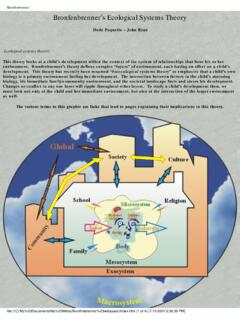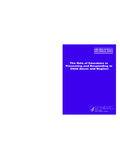Transcription of Bronfenbrenner’s Ecological Systems Theory
1 BronfenbrennerBronfenbrenner s Ecological Systems Theory Dede Paquette John Ryan Ecological Systems Theory :This Theory looks at a child s development within the context of the system of relationships that form his or her environment. bronfenbrenner s Theory defines complex layers of environment, each having an effect on a child s development. This Theory has recently been renamed bioecological Systems Theory to emphasize that a child s own biology is a primary environment fueling her development. The interaction between factors in the child s maturing biology, his immediate family/community environment, and the societal landscape fuels and steers his development.
2 Changes or conflict in any one layer will ripple throughout other layers. To study a child s development then, we must look not only at the child and her immediate environment, but also at the interaction of the larger environment as various terms in this graphic are links that lead to pages explaining their implications in this :///C|/My%20 Documents/My%20 Webs/Bronfnebrenner%20 (1 of 4) [7/12/2001 6:36:39 PM] bronfenbrenner bronfenbrenner s structure of environment: The microsystem this is the layer closest to the child and contains the structures with which the child has direct contact. The microsystem encompasses the relationships and interactions a child has with her immediate surroundings (Berk, 2000).
3 Structures in the microsystem include family, school, neighborhood, or childcare environments. At this level, relationships have impact in two directions - both away from the child and toward the child. For example, a child s parents may affect his beliefs and behavior; however, the child also affects the behavior and beliefs of the parent. bronfenbrenner calls these bi-directional influences, and he shows how they occur among all levels of environment. The interaction of structures within a layer and interactions of structures between layers is key to this Theory . At the microsystem level, bi-directional influences are strongest and have the greatest impact on the child.
4 However, interactions at outer levels can still impact the inner structures. The mesosystem this layer provides the connection between the structures of the child s microsystem (Berk, 2000). Examples: the connection between the child s teacher and his parents, between his church and his neighborhood, etc. The exosystem this layer defines the larger social system in which the child does not function directly. The structures in this layer impact the child s development by interacting with some structure in her microsystem (Berk, 2000). Parent workplace schedules or community-based family resources are examples.
5 The child may not be directly involved at this level, but he does feel the positive or negative force involved with the interaction with his own system . The macrosystem this layer may be considered the outermost layer in the child s environment. While not being a specific framework, this layer is comprised of cultural values, customs, and laws (Berk, 2000). The effects of larger principles defined by the macrosystem have a cascading influence throughout the interactions of all other layers. For example, if it is the belief of the culture that parents should be solely responsible for raising their children, that culture is less likely to provide resources to help parents.
6 This, in turn, affects the structures in which the parents function. The parents ability or inability to carry out that responsibility toward their child within the context of the child s microsystem is likewise affected. The chronosystem this system encompasses the dimension of time as it relates to a child s environments. Elements within this system can be either external, such as the timing of a parent s death, or internal, such as the physiological changes that occur with the aging of a child. As children get older, they may react differently to environmental changes and may be more able to determine more how that change will influence them.
7 Nature vs. Nurture? More modern child development theories accept that both a child s biology and his environment play a role in change and growth. Theories now focus on the role played by each and the extent to which they interact in ongoing file:///C|/My%20 Documents/My%20 Webs/Bronfnebrenner%20 (2 of 4) [7/12/2001 6:36:39 PM]Bronfenbrennerdevelopment. bronfenbrenner s Ecological Systems Theory focuses on the quality and context of the child s environment. He states that as a child develops, the interaction within these environments becomes more complex. This complexity can arise as the child s physical and cognitive structures grow and mature.
8 So, given that nature continues on a given path, how does the world that surrounds the child help or hinder continued development? This is the question answered by bronfenbrenner s Theory . Urie bronfenbrenner , co-founder of Head Start, uses his bioecological model to provide a startlingly clear view of the problems we have been seeing in our students and in our families. He says that technology has changed our society, and while we are taking great pains to safeguard the physical environment from the damage done by a technology, we have spent no resources to provide similar safeguards to the damage done to our societal environment.
9 (Henderson, 1995). Our economy has shifted from an industrial model to a technological model, yet the patterns of the workplace have continued to rely on the factory work ethic. Parents are expected to work a schedule that revolves around the factory whistle even though they may work in a high tech office. The technology that enables workers to be free of manual labor, should also free them from the time and place boundary. Yet, our work ethic demands more face time not less. As women entered the work force, they too were subject to the same demands. Family life in this country has taken a back seat to the needs of the workplace.
10 Also of concern to bronfenbrenner is the deficit model used to determine the level of support granted by the public to struggling families. Parents must declare themselves deficient in some way in order to qualify for help in solving problems that may come about because of our cultural value of independence. A larger degree of failure means a larger amount of support. By working from this deficit model, we expect families to hold their hands up from deep inside a black hole of helplessness. Then, we expect them to have the psychological strength to climb up the thin rope the throw down. Implications for practiceBronfenbrenner sees the instability and unpredictability of family life we ve let our economy create as the most destructive force to a child s development (Addison, 1992).




